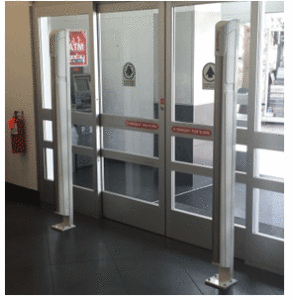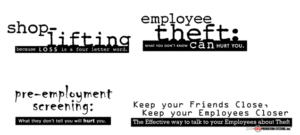 What is the solution to shoplifting and employee theft? Are harsher punishment by law the solution to this devastating social problem? Technology aimed to help retail stores prevent this problem do not seem to be helping yet. As the technology advances, so does the professional shoplifter. Meanwhile the losses due to shoplifting and employee theft are becoming retailers greatest problems to date.
What is the solution to shoplifting and employee theft? Are harsher punishment by law the solution to this devastating social problem? Technology aimed to help retail stores prevent this problem do not seem to be helping yet. As the technology advances, so does the professional shoplifter. Meanwhile the losses due to shoplifting and employee theft are becoming retailers greatest problems to date.
For more about this and other stories, follow the links below.
Shoplifting: Retail’s $45 Billion Problem
Retailers are struggling to keep tabs on shoplifters who are increasingly becoming their top source of loss, averaging $377 per incidence, up $60 from the year before.
At 39 percent, shoplifting was found to be the biggest contributor among factors that led to overall inventory shrinkage in 2015 causing a $45.2 billion loss across the United States, according to NRF’s 2016 National Retail Security survey. The new numbers reflect a $1.2 billion increase in losses from 2014.
The inventory shrink averaged 1.38 percent of retail sales and saw 47 percent of retailers reporting losses in 2015.
“With a constantly evolving retail landscape, loss prevention becomes more complex every day,” said NRF Vice President of Loss Prevention Bob Moraca. “LP professionals have been working diligently to find advancements in technology aimed at deterring crime in our industry, sometimes even before it happens – but as our techniques get more sophisticated, so too do the criminals.”
Another factor adding to inventory shrinkage was a rise in robberies that exclusively targeted jewelry stores. The average loss reported by robbed stores increased from $2,465 per incidence in 2014 to $8,180.17 last year.
RETAIL INVENTORY SHRINKAGE INCREASED TO $45.2 BILLION IN 2015
The 2016 National Retail Security Survey, conducted in collaboration by the National Retail Federation and the University of Florida, reveals that retailers’ inventory shrink averaged 1.38 percent of retail sales, or $45.2 billion in 2015, up by $1.2 billion from 2014.
According to the report, 47 percent of retailers surveyed reported increases in overall inventory shrink in 2015, with shoplifting accounting for the greatest cause with an average loss of $377 per incident (39 percent), up nearly $60 from 2014.
Robberies continue to be a growing expense for retailers, costing an average of $8,180.17, up from $2,465. The rise in robberies in 2015 was driven by an increase in jewelry stores reporting extremely high average losses.
“With a constantly evolving retail landscape, loss prevention becomes more complex every day,” said NRF Vice President of Loss Prevention Bob Moraca. “LP professionals have been working diligently to find advancements in technology aimed at deterring crime in our industry, sometimes even before it happens – but as our techniques get more sophisticated, so too do the criminals.”
Gieves & Hawkes Installs RFID to Prevent Shrinkage, Track Inventory
The U.K. men’s wear retailer is using a solution from Catalyst to invisibly secure the doorway at its two newest stores, and to make sure its products are always in stock.
Apr 05, 2016—
To improve inventory visibility and prevent loss, men’s clothing retailerGieves & Hawkes has deployed a radio frequency identification system at its store in Birmingham, England. The solution tracks goods as they are received and stored in the back room or store front, then prevents unpurchased merchandise from being taken out the front door by sounding an alert, as well as storing data regarding which item is being removed. The company is expanding its RFID deployment to its newest store, located in of Hackney, an East London borough. The technology is provided by RFID solutions companyCatalyst. Both Gieves & Hawkes and Catalyst are owned by Li & Fung.
Gieves & Hawkes is a high-end men’s custom and ready-to-wear clothing retailer based in London, with more than 200 stores in China alone, as well as eight stores in the United Kingdom. The company was founded in 1771, making it one of the world’s oldest tailors. Britain’s royal family and royal military have worn its custom suits and clothing for several centuries. (Gieves & Hawkes did not respond to requests for comment.)
 Employee theft is a common and costly problem in retail. Some businesses’ are reporting that, for the first time, internal pilferage has now surpassed external. There are many ways to control and manage internal theft. But, one of the most effective ways is often overlooked. Stop it before it starts.
Employee theft is a common and costly problem in retail. Some businesses’ are reporting that, for the first time, internal pilferage has now surpassed external. There are many ways to control and manage internal theft. But, one of the most effective ways is often overlooked. Stop it before it starts. According to the National Retail Federation-
According to the National Retail Federation- Do you REALLY know how to stop shoplifters? I mean, really know? Your Checkpoint System is only half of the strategy. You spent the money, put the labor/time into using labels and tags but after the newness wears off, are you still having more losses than you want?
Do you REALLY know how to stop shoplifters? I mean, really know? Your Checkpoint System is only half of the strategy. You spent the money, put the labor/time into using labels and tags but after the newness wears off, are you still having more losses than you want?
 It’s no big secret that I can’t stand a thief; I did make a career out of catching them. Shoplifters really get under my skin, but employee theft really fires me up. You put people to work, give them opportunity to grow and instead of putting in the long hours, hard work and dedication needed to move forward, they steal from you. They betray your trust, slap you in the face and take money out of your pocket and food off your family’s table. Will you ever stop employee theft completely? Probably not. You can, however, minimize the risk.
It’s no big secret that I can’t stand a thief; I did make a career out of catching them. Shoplifters really get under my skin, but employee theft really fires me up. You put people to work, give them opportunity to grow and instead of putting in the long hours, hard work and dedication needed to move forward, they steal from you. They betray your trust, slap you in the face and take money out of your pocket and food off your family’s table. Will you ever stop employee theft completely? Probably not. You can, however, minimize the risk. Whether you’re a small one store business, or a large chain store, loss prevention awareness training for your teams cannot only protect against criminal acts, but also make a direct and positive impact on your bottom line. There is an inherent value in awareness training that lots of managers just don’t take advantage of. The core of any successful loss prevention program is not how many shoplifters are caught, nor is it how many employees were arrested; it’s training and awareness of your store teams. We are called loss “prevention,” not loss “reaction,” right? So how do you persuade your managers to see the value?
Whether you’re a small one store business, or a large chain store, loss prevention awareness training for your teams cannot only protect against criminal acts, but also make a direct and positive impact on your bottom line. There is an inherent value in awareness training that lots of managers just don’t take advantage of. The core of any successful loss prevention program is not how many shoplifters are caught, nor is it how many employees were arrested; it’s training and awareness of your store teams. We are called loss “prevention,” not loss “reaction,” right? So how do you persuade your managers to see the value?

